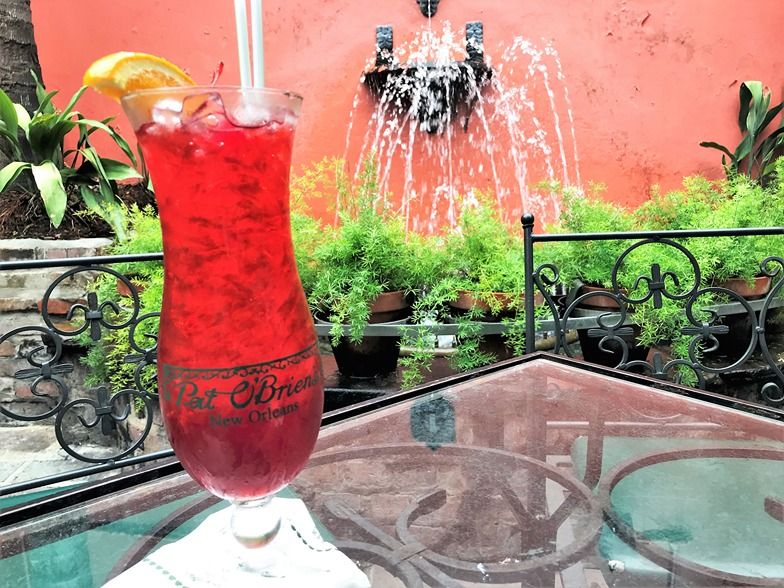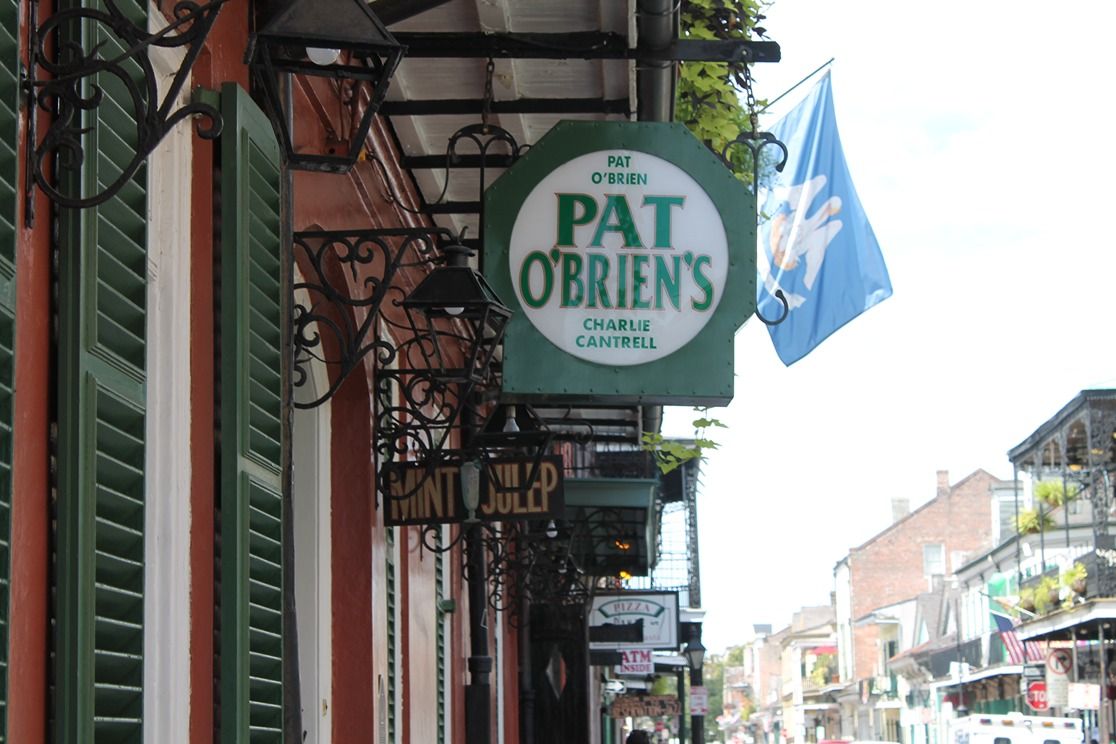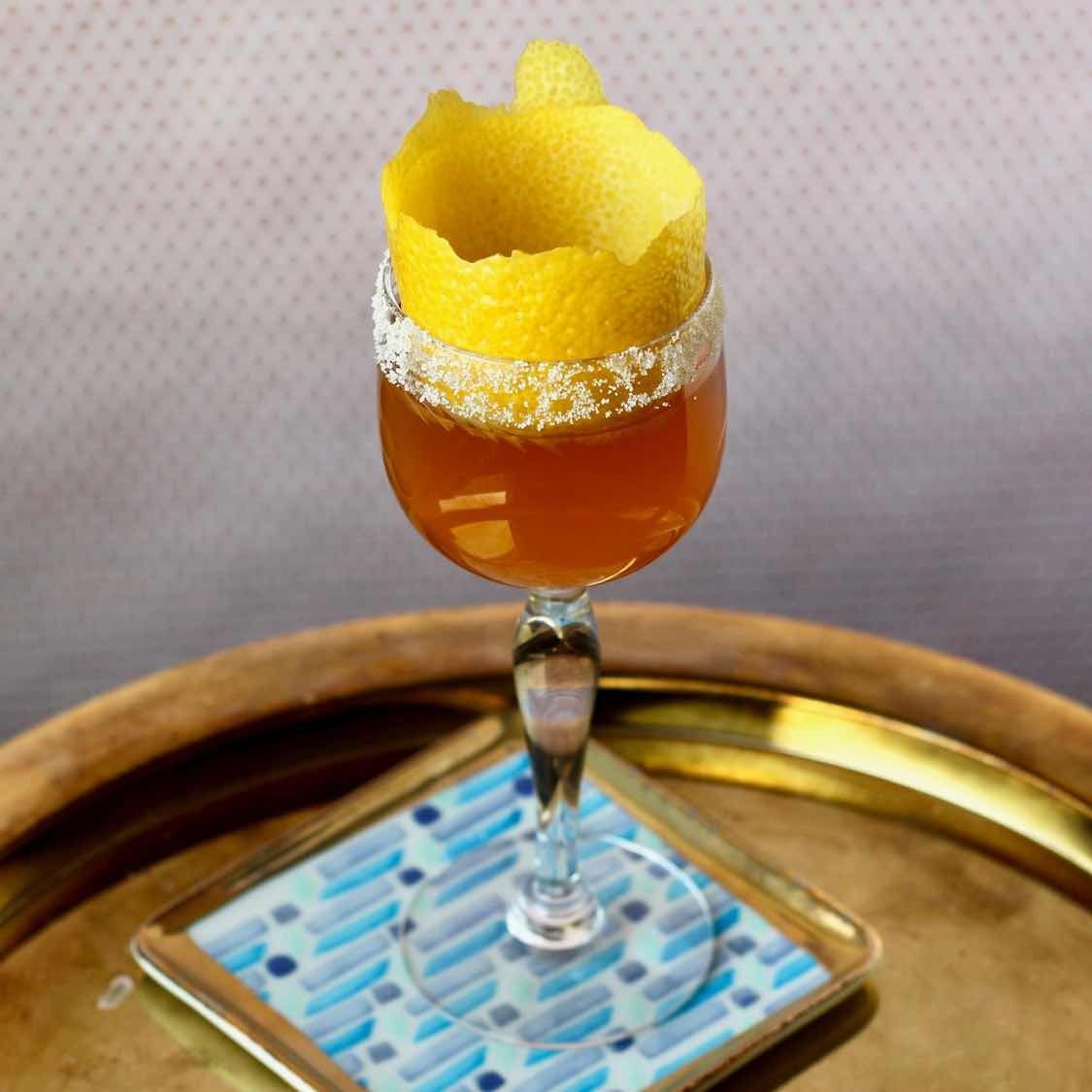The Hurricane—as created by Pat O'Brien's
It would not be reasonable to expect that a favorite cocktail of New Orleans would have any more of a straightforward tale than the twisted history traveled by the city that gave birth to it.
In New Orleans, references to compass points have to be abandoned, the sun rises over the Westbank, the topography is defined by man-made Monkey Hill—at 30-ft. above sea level, it's not the tallest dirt point in town, it's but close—and North America's mightiest river twists and turns within the city's political limits. It is only logical that a cocktail made famous here would have an interesting backstory.
Pat O'Brien, a saloon owner of some repute, was actually proprietor and bartender of an illegal establishment, Mr. O'Brien's Club Tipperary, established near the corner of Royal Street and St. Peter in early 1930. The illegality of the spot was due to the fact that Prohibition was in full effect in America and service of any alcohol was banned. In New Orleans, we actually considered federal law, namely the 18th Amendment to the U.S. Constitution, to be a suggestion. Not adhering to the strict statement of the law was not necessarily a grievous legal offense.
Mr. O'Brien's establishment, like all speakeasies, required a spoken password in order to enter through a locked door. The current story is that the password was "storm's a-brewin'" or "storm's brewin'." Those may have been passwords, but, by necessity, passwords changed frequently to keep U.S. revenue agents and unwelcome guests on the outside. The "storm's a-brewin" legend was actually begun by a reporter from the New York Times several years after Prohibition ended because he thought it made for better copy in an assigned story requested by his editor.

O'Brien picked up his illegal products from a multitude of places, including from New Orleans neighbors who made alternative use of their bathtubs. When quantity was needed, O'Brien would drive to the Mississippi Gulf Coast, meet a booze-laden boat on the beach, load up his car, and drive back to his club on St. Peter through the Rigolets along the coast and under cover of darkness.
Even when Prohibition was repealed with the 21st Amendment in December 1933, O'Brien proved his rebelliousness to the end by opening his Club Tipperary to the public during the last two days of Prohibition. He was confident that no revenue agent was going to affect an outgoing law when, all along, they had not enforced the law when it was in full force.
O'Brien's business at the club was very good. It was so good, in fact, that O'Brien and his partner Charley Cantrell were encouraged to look for a larger venue. They did not have to look very far. Literally in the next block, the 700 block of St. Peter, was a large available space. The partners signed a lease deal and proceeded with sprucing the place up, which included a large patio that was perfect for enjoying cocktails. The partners renamed Club Tipperary to Pat O'Brien's in late 1933 and moved to 718 St. Peter in 1942 to a building constructed in 1791, the current home of the bar.

The years between Prohibition and the outbreak of the World Wars were not easy for bar owners. Product for a variety of reasons was in short supply. In particular, there was a shortage of spirits. Whisky, scotch, and liqueurs were almost impossible to purchase, and when purchases were made, pricing was not favorable.
The companies that sold such spirits placed limits on how much product customers could buy. Also, when a customer was good enough to earn the right to buy brown spirits, other products had to be purchased alongside. O'Brien convinced Cantrell that this system could still work to their advantage.
One of the alcohol items of which there was no limit was rum. Manufactured relatively near New Orleans and with low prices, O'Brien turned the advantage back towards himself and Cantrell. Sometime in the early 1940s, O'Brien invented a cocktail composed of light and dark rum, vodka, gin, passion fruit, grenadine, and simple syrup—a sugar rush, indeed.
Now, they had to name the cocktail, and O'Brien suggested "Hurricane;"
however, there already was a cocktail named that. O'Brien had a brainstorm to
top all brainstorms. He suggested to his partner that they create specialty
glassware in the shape of hurricane lamps well-known to New Orleanians. Then,
the partners said that the glassware would be available for customers to
purchase on the spot—souvenirs, if you will. Patrons could be "sales
ambassadors" for Pat O'Brien's, taking the bar's story to the streets or back
home to be placed in a cherished spot, all the while alleviating the need for
the bar to wash the glass. It was pure genius.
The Original Hurricane Cocktail
Rum (usually aged rum or equal parts aged and white)
2 oz. passion fruit syrup
2 oz. lemon juice
Add all ingredients to a cocktail shaker with a couple small pieces of ice.
Shake until the ice has dissolved, then open pour the cocktail into a Hurricane glass filled with crushed ice.
Stir, top with more crushed ice, and garnish with an orange slice and a cocktail cherry.
Pat O'Brien's Hurricane Cocktail
1 ounce Vodka (or 2 tablespoons)
1 ounce Gin (or 2 tablespoons)
2 ounces Gold Rum (or 1 ounce each of light and dark rum)
1 ounce Amaretto Almond Liqueur (or 2 tablespoons)
1 ounce Triple Sec (or 2 tablespoons, or orange liqueur)
1 tablespoon Grenadine
Add Juice (+ pineapple juice and/or passion fruit puree, as needed)
Add Simple Syrup (optional)
Highball Glass
Garnish: Fruit Slices, Cherries
Straws
1. Slice an orange in half and place the flat side down on a cutting board. Slice it into quarter-inch thick half-moons, one for each drink.
2. Fill each Hurricane glass, or the tallest glass you have, about halfway with ice to chill.
3. Fill a cocktail shaker with ice. Add the rum, passion fruit juice, lime juice, orange juice, and grenadine to the shaker.
4. Shake vigorously for about 20-30 seconds or until the shaker is frosty on the outside.
5. Strain the mixture into a Hurricane glass filled with fresh ice.
6. Garnish with an orange slice and a maraschino cherry for that final tropical touch.
The Italian Connection
It's no surprise that New Orleans is a long-time respected epicenter of the cocktail world. We've known that for 190 years, and we are not just a "flash in the pan."
Sometimes when there is an abundance of riches, certain items can be overlooked, even forgotten. Such a recipe is the Brandy Crusta. What? You've never heard of such a cocktail? You are about to get an education.
We all are aware of the sacred place the Sazerac holds in New Orleans cocktail lore. It's the first and likely the most famous. It's a perfect reflection of our heritage, both American and French, and it's easy to make and so smooth.
Trivia question: Do you know the second mixed alcoholic beverage to be invented in New Orleans in the mid-1800s? If so, and you are among the overwhelming minority, do you know the heritage of this cocktail? And do you know where it is still regularly and properly served?
Stick around for the answers.

About Sours
There is a class of cocktails known as "sours." The reason for the name is obvious. Early cocktails were based on the needs of sailors to fight disease, such as scurvy, on long ocean voyages. Yep, that reason to drink was developed by necessity, not necessarily pleasure, although pleasure was a wonderful side benefit. Sailors were at sea a long time under very unsanitary conditions. Because England ruled the seas and the conquering nation had extensive holdings in the New World, rum, that indigenous Caribbean spirit, became a favorite shipboard beverage. Every sailor had a daily ration of rum.
Rum, as we are all aware, is distilled from sugar and fruit, so it's sweet. That flavor does not fit well in all situations. Dining, for instance, may pair well with a sweet beverage. Then again, it may not. Around 1850, the issue was addressed, and spirits were also concocted from citrus. So citrus-based spirits were called "sours."
To be fair, neither sours nor sweets were distilled entirely of either raw product style. Our distillery-owning forefathers realized that a good combination of sugar and citrus yielded a decidedly tasty outcome. But there were/are styles tilted toward one dominant profile. As is known, cocktails are blends of multiple ingredients, many of which are organic, and those ingredients themselves are the result of well-defined products that grow well in certain soils. Then, the resulting "mash" is maneuvered with processes in specific vessels of well defined materials. The fruit falling off the plant is only the beginning and often is the easy part.
Anyway, every cocktail is dependent on the talented hands and mind of a human adding in the correct ingredients in the proper measure at the right time. Seems much simpler when you step up to the bar and give the bartender your order, doesn't it?
Joseph Santini
And as many humans have worked behind the bar over the course of hundreds of years, only a few have left their marks. Such an outstanding talent was Joseph Santini, a native of Trieste, Italy, which is in the northeastern part of that wonderful country. Trieste is the governmental seat of the Friuli region, not far from Venice.
Santini loved to create cocktails made from spirits in a region more closely allied with wine and grapes. His wanderlust brought him to America about 1840—more specifically to New Orleans, a major port city and a town that had a large Italian population.
He immediately gravitated to the bar scene in the Vieux Carré and then opened his own place in the American Sector on Gravier Street. He was very good at his chosen profession and created many named cocktails. One of them took the cocktail ingredients from the French side of town, namely brandy, and added some ingredients from his heritage such as cardamom bitters, lemon juice, and orange liqueur.
He then coated the rim of the glass with sugar to excite the palate and tone down the citrus aspects. But Santini himself liked citrus, so he added to the drink about half of the rind from the lemon, rolled and placed along the interior shape of the glass. Brandy Crusta was born in 1854 at Santini's bar, Jewel of the South, located at 1026 St. Louis St. near Rampart Street.
The drink was an immediate hit and made Santini a very famous bartender. It also made Jewel of the South a must-do destination. Santini was not, however, a one-hit wonder. He also created the frozen egg nog—a very popular drink in semi-tropical New Orleans—and the Pousse Café, a magical stack of various liqueurs that demonstrates the knowledge of the specific gravity of the various ingredients, as well as the steady hand of anyone who attempts to construct the drink.
Joseph Santini passed away in 1874, having assured his adopted city a permanent and treasured position in the cocktail world. He is interred in St. Louis Cemetery No. 3, and his grave is a destination, even today, for professionals and amateurs alike who want to honor a talented and dedicated New Orleans transplant.
To complete the circle, Jewel of the South, not too long ago awarded the designation as one of the Best Bars in the U.S. and a James Beard Award winner, features Santini's Crusta as a specialty.
Brandy Crusta Recipe
1 Serving
(Note: When the history of a cocktail goes back this far, along the way, changes will have been made to the style or the ingredients. We endeavor to stick as closely as possible to the original recipe.)
Ingredients
-1 tsp. Lemon Juice
-1/3 oz. Gum Syrup
-1 tsp. Orange Liqueur
-1 dash Cardamom Bitters
-2 oz. Brandy
Directions
Technique: Simple Stir
-Moisten a cocktail glass rim with a cut lemon slice and rub the end in granulated sugar to create a sugar crust.
-Combine all ingredients in the mixing glass.
-Add ice to the mixing glass.
-Stir the ingredients for 10 to 15 seconds. Try to avoid over-diluting the drink.
-Strain into a glass.
Sazerac
Let's clear a local common misconception: The cocktail concept was not invented in New Orleans.
This style of adult beverage, making use of fruit juice, spice or bitters, and a spirit (or two), was actually created in England or New York, depending on who is providing the history.
There is still much discussion about how the term "cocktail" came to be affixed on the drink. Some have claimed the earliest versions were served in a coquetier, a French cup used to serve eggs, and that the name was a derivative of what Americans could pronounce. "Coquetier" became "cocktail." It's a good story, but it's not true.
More likely, the term "cocktail" was the action and spices, notably ginger, that were placed up the back end of a racehorse, causing the animal to keep its tail in the air during racing. The ingredients, not the ones previously used on the animal, were also incorporated into the mixed adult beverages served in taverns. All of this happened in the late 1700s.
What is true, however, is that New Orleans was an early adapter and appreciator of cocktails. They were a breakfast favorite, sort of a good-for-what-ails-you way to get your day going.
A special local favorite was created by a young pharmacist behind the counter at his Royal Street apothecary in the early 1840s. Antoine Amédée Peychaud, a Creole from Saint-Domingue, now known as Haiti, concocted the bitters that bear his name to this day. Bitters are an intense blend of various spices and fruit essences used to add flavors or aromas to whatever is being prepared, usually a beverage or a food recipe. Peychaud probably created his start-the-day drink without adding any alcoholic spirit. Then in the late 1840s, he decided that the drink's recipe lent itself to become a member of the "new" category of cocktails—adult beverages.
Since he now had a popular drink served only at his pharmacy in both alcoholic and non-alcoholic forms, he felt that he needed to distinguish the two versions. He couldn't have the kids being served an adult beverage, especially one as potent as his creation. In those times, unlike our time period, cocktails were not named. Drinks were served exclusively at the emporium where they were invented.
But Peychaud now had two styles of the same recipe, basically, so he came up with a revolutionary idea. The alcohol version of his creation would go by the name of its main spirit ingredient, which happened to be Sazerac de Forge et Fils Cognac. And because Peychaud's neighborhood was French with a taste for a spirit that originated in Switzerland, absinthe, he added a dash of that distinctive anise liqueur. So was born in New Orleans the oldest named cocktail in the world—the Sazerac.
Yet, the road since the mid-1850s has not been smooth or even logical. With the success of the Sazerac came a number of aspiring cocktails. The first in a very long line of derivative cocktails was the Brandy Crusta, still featured in a number of bars.
In the late 1800s, disaster struck the European agriculture community. The root louse attacked vineyards, literally sucking the life out of the vines from deep in the soil. Vines underproduced fruit and then died a slow death. It was a long process to eradicate the pest from the soil, which required fields to lay fallow for years. That was followed by the long maturation period to allow newly planted vines to establish themselves and then show maturation. All the while, the liquid that would become wine was scarce.
Good fortune would smile upon New Orleans in regards to finding the right ingredient to substitute for the key spirit in the Sazerac cocktail. New Orleans was a key seaport at the southern end of the great river that served America's heartland. Through this place flowed the best of whiskey from Tennessee and Kentucky. New Orleans was awash in whiskey.
Out with the cognac, unavailable at any cost, and in with another flavor enjoyed by thirsty natives—rye whiskey. The changeover was swift and painless. The beloved Sazerac was saved by a product that was already here. To this day, most Sazeracs served use rye whiskey as the base spirit. Interestingly, the name of the cocktail never changed. It was still called by the name of the cognac.
Then came another challenge. Absinthe was popularly blamed for a culture of alcohol surplus. Since absinthe is 45% alcohol by volume, a very high quantity, delusional acts of violence and self-destruction have been blamed on the spirit. The drink was even nicknamed "The Green Fairy" to account for the out-of-this-world mental effects. Vincent van Gogh—the Post Impressionist master artist—and Toulouse Lautrec were both addicted to absinthe.
In the first decade of the 20th century, France, Switzerland, and, eventually, the U.S. passed laws banning the sale of absinthe. Pastis and sometimes ouzo served as pale substitutes for absinthe in the Sazerac. So now two major and key ingredients in the Sazerac were no longer being used, but the cocktail still retained its popularity and original name.
The ultimate test was yet to come. In 1919, the US passed the 18th Amendment to the Constitution, which prohibited the sale of any alcohol beverage anywhere in the country. So began a period of 14 years of Prohibition, during which obtaining a cocktail or any spirit was an illegal act.
The Sazerac, as we all know, survives and thrives to this day. In 2008, the Louisiana Legislature passed an act naming the Sazerac as the Official Cocktail of New Orleans.
INGREDIENTS
1.5 oz. Sazerac Rye Whiskey
1 sugar cube
3 dashes Peychaud's Bitters
.25 oz. Herbsaint
Lemon twist
PREPARATION
Pack a rocks glass with ice. In a second rocks glass, place a sugar cube and add three dashes of Peychaud's Bitters to it. Crush the sugar cube. Add 1.5 oz. Sazerac Rye Whiskey to the glass with the Peychaud's Bitters and sugar. Add ice and stir. Empty the ice from the first glass and coat the glass with .25 oz. Herbsaint. Discard the remaining Herbsaint. Strain the whiskey/bitters/sugar mixture from the glass into the Herbsaint coated glass and garnish with a lemon peel.
If you wish, substitute equal quantity Sazerac de Forge Finest Original Cognac for Sazerac Rye Whiskey.

